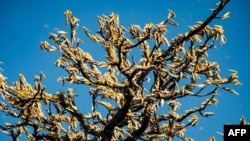ໃນຂະນະທີ່ຕັກແຕນທະເລຊາຍໄດ້ແຜ່ລາມໄປທົ່ວເຂດ ອາຟຣິກາ ຕາເວັນອອກ, ປະເທດ ອູການດາ ກໍໄດ້ສົ່ງກອງທັບຂອງເຂົາເຈົ້າໄປຕໍ່ສູ້ກັບຝູງຕັກແຕນທີ່ກິນໝົດທຸກຢ່າງນັ້ນ. ສັດຕູພືດດັ່ງກ່າວແມ່ນກຳລັງວາງໄຂ່ຈຳນວນຫຼວງ ຫຼາຍທີ່ຄາດວ່າຈະເບາະພາຍໃນບໍ່ເທົ່າໃດອາທິດນີ້, ເຊິ່ງໄດ້ກໍ່ໃຫ້ບັນດາຊາວນາຊາວສວນມີຄວາມເປັນຫ່ວງວ່າ ຈະມີສິ່ງຮ້າຍແຮງເກີດຂຶ້ນໃນອະນາຄົດ. ນັກຂ່າວວີໂອເອ ຮາລີມາ ອາຕູມານີ ມີລາຍງານຈາກເມືອງ ໂອຕູເກ, ທາງພາກຕາເວັນອອກສຽງເໜືອຂອງປະເທດ ອູການດາ, ເຊິ່ງ ພຸດທະສອນ ຈະນຳລາຍລະອຽດມາສະເໜີທ່ານໃນອັນດັບຕໍ່ໄປ.
ອູການດາ ແມ່ນປະເທດທີ່ຕັ້ງຢູ່ ອາຟຣິກາ ຕາເວັນອອກປະເທດຫຼ້າສຸດທີ່ກຳລັງຕໍ່ສູ້ກັບການຮຸກຮານຂອງຕັກແຕນທະເລຊາຍຫຼາຍລ້ານໂຕ ຫຼັງຈາກສັດຕູພືດດັ່ງກ່າວໄດ້ຂ້າມເຂດຊາຍແດນປະເທດ ເຄັນຢາ ເຂົ້າໄປ ໃນເດືອນນີ້.
ບັນດາຊາວນາເຊັ່ນທ່ານ ທັອມມັສ ອອນຢາງໂກ, ໃນບ້ານ ໂອຣິງໂກ-ໂອລເຢັຈ໌, ໄດ້ຕື່ນຂຶ້ນມາໃນຕອນເຊົ້າມື້ນຶ່ງ ແລະ ພົບເຫັນວ່າສວນຂອງລາວແມ່ນກຳລັງຖືກກິນ.
ທ່ານ ທັອມມັສ ອອນຢາງໂກ ໄດ້ກ່າວວ່າ “ເຄິ່ງນຶ່ງຂອງສວນ, ຕົ້ນມັນຕົ້ນແມ່ນບໍ່ມີໃບ. ເວລາເຈົ້າກວດເບິ່ງໝາກຖົ່ວແປບ, ໃບຂອງມັນແມ່ນໄດ້ຫາຍໄປໝົດ, ແມ່ນກະທັ້ງໝາກໄມ້ທີ່ຂ້າພະເຈົ້າຄາດວ່າຈະເກັບກ່ຽວ, ຕອນນີ້ມັນກອງຢູ່ພື້ນດິນໝົດ.”
ບັນດາເຈົ້າໜ້າທີ່ເວົ້າວ່າ ປະມານ 20 ເມືອງໃນພາກຕາເວັນອອກສຽງເໜືອຂອງ ອູການດາ ແມ່ນໄດ້ຮັບຜົນກະທົບໃນປັດຈຸບັນນີ້.
ເພື່ອສູ້ກັບບັນຫາຄືນນັ້ນ, ອູການດາ ໄດ້ສົ່ງກອງກຳລັງຕິດອຸປະກອນປາບສັດຕູພືດ 2,000 ຄົນອອກໄປ.
ແຕ່ນາຍພົນ ແຊມ ຄາວູມາ ໄດ້ກ່າວວ່າ ພວກຕັກແຕນແມ່ນມີທັກສະໃນການຫຼົບຫຼີກການຕອບໂຕ້ຄືນ.
ນາຍພົນ ແຊມ ຄາວູມາ, ຜູ້ປະສານງານການສີດຢາ, ຈາກກອງກຳລັງປ້ອງກັນປະຊາຊົນ ອູການດາ ໄດ້ກ່າວວ່າ “ສິ່ງທ້າທາຍນຶ່ງ, ເຊິ່ງໄດ້ຖືກແກ້ໄຂແລ້ວ, ນັ້ນກໍແມ່ນການສະໜັບສະໜູນທາງອາກາດ ເພື່ອສີດຢາຈາກອາກາດ. ເພາະວ່າ, ສຳລັບພວກເຮົາ ພວກເຮົາຮັບມືກັບພວກທີ່ວ່າຢູ່ພື້ນດິນເປັນສ່ວນຫຼາຍ. ແລະ ເວລາພວກເຮົາຂ້າມັນ, ຫຼືໃນລະຫວ່າງການສີດຢານັ້ນ, ມັນຈະເຕັ້ນຂຶ້ນ ແລະ ຂຶ້ນໄປຢູ່ປາຍຕົ້ນໄມ້ພຸ້ນ ບ່ອນທີ່ປ້ຳສີດຂອງພວກເຮົາໄປບໍ່ຮອດ.”
ບັນດາເຈົ້າໜ້າທີ່ ອູການດາ ເວົ້າວ່າ ເຂົາເຈົ້າກຳລັງເຮັດວຽກເພື່ອເອົາ ເຮລິຄັອບເຕີມາສີດຢາທາງອາກາດ.
ໃນຂະນະດຽວກັນ, ກອງທັບບົກແມ່ນໄດ້ຂະຫຍາຍອອກໄປ ໃນຂະນະທີ່ເຂົາເຈົ້າໄລ່ຝູງສັດຕູພືດທີ່ເຄື່ອນຍ້າຍຢ່າງເປັນປະຈຳ ແລະ ປະຊາຊົນໃນທ້ອງຖິ່ນກໍມີແຕ່ໃຊ້ເຄື່ອງມືຂອງເຂົາເຈົ້າເອງເພື່ອໄລ່ແມງໄມ້ພວກນັ້ນໜີ.
ນາງ ຊາຣາ ອາແຄລໂລ ຜູ້ອາໄສຢູ່ບ້ານ ໂອຕູເກ ໄດ້ກ່າວວ່າ “ຕັກແຕນດັ່ງກ່າວມັນກິນຫຍ້າ ບ່ອນທີ່ຂ້າພະເຈົ້າລ້ຽງສັດຂອງຂ້າພະເຈົ້າ, ແບ້, ງົວ ແລະ ອື່ນໆ.”
ບັນດາຜູ້ຊ່ຽວຊານ ກ່ຽວກັບ ຕັກກະແຕນ ເວົ້າວ່າ ຖ້າຝູງຕັກແຕນນັ້ນບໍ່ຖືກຢຸດ, ໄຂ່ທີ່ມັນວາງອອກນັ້ນ ກໍຈະເບາະພາຍໃນສອງອາທິດ ແລະ ຈຳນວນການບຸກລຸກນັ້ນກໍຈະເພີ່ມສູງຂຶ້ນຢ່າງວ່ອງໄວ.
ທ່ານ ຈອນ ບາຮານາ, ຜູ້ຊ່ຽວຊານ ກ່ຽວກັບ ຕັກແຕນ ຢູ່ກະຊວງກະສິກຳ ອູການດາ ໄດ້ກ່າວວ່າ “ຄວາມໝາຍຂອງມັນກໍແມ່ນວ່າ ຖ້າໄຂ່ຖືກວາງອອກ ແລະ ເບາະດ້ວຍຄວາມສຳເລັດ, ແລ້ວພວກເຮົາກໍຈະປະເຊີນກັບອີກລຸ້ນນຶ່ງ ແລະ ລຸ້ນນັ້ນຈະຄູນຂຶ້ນເປັນສີ່ເທົ່າ, ຫ້າເທົ່າຂອງຈຳນວນປະຊາກອນດັ້ງເດີມ. ສະນັ້ນ ມັນຈະເປັນການເພີ່ມຂຶ້ນຢ່າງໃຫຍ່ຫຼວງ. ມັນແມ່ນການເພີ່ມຂຶ້ນທີ່ອາດເປັນຕາຢ້ານ.”
ບັນດານັກຊ່ຽວຊານເວົ້າວ່າ ອາກາດອົບອຸ່ນ ແລະ ຝົນຕົກໜັກຢູ່ອ້ອມຊາຍຝັ່ງທະເລແດງ ໄດ້ກະຕຸ້ນໃຫ້ມີການແຜ່ພັນຂອງຕັກແຕນໃນປະເທດ ຈີບູຕີ, ເອຣິເທຣຍ ແລະ ຊູດານ.
ພວກສັດຕູພືດໄດ້ກິນພືດພັນຕ່າງໆໃນປະເທດ ເອທິໂອເປຍ, ໂຊມາເລຍ, ແທນຊາເນຍ, ແລະ ອູການດາ ໃນການຄຸກຄາມຂອງຝູງຕັກແຕນທີ່ຮ້າຍແຮງທີ່ສຸດໃນຮອບຫຼາຍທົດສະວັດ.
ຖ້າມັນບໍ່ຖືກຄວບຄຸມ, ບັນດາເຈົ້າໜ້າທີ່ເວົ້າວ່າ ຕັກແຕນທະເລຊາຍ ອາດເປັນໄພຂົ່ມຂູ່ຕໍ່ຄວາມໝັ້ນຄົງດ້ານອາຫານໃນທົ່ວພາກພື້ນ.
As desert locusts spread across East Africa, Uganda has deployed its army to battle the all-consuming horde. The pests are laying countless eggs that are expected to hatch within weeks, raising concerns among farmers that the worst is yet to come.
Uganda is the latest East African country battling an invasion of millions of desert locusts after the pests this month crossed the Kenya border.
Thomas Onyango, a farmer in Oringo-Olyech village, woke one morning to find his garden being consumed.
“Half of the garden, there are no leaves on the cassava. When you check on the pigeon peas, all the leaves are gone, even the fruits that I was expecting to harvest, now they are all down on the ground," said the farmer.
Authorities say about 20 districts in northeast Uganda so far are affected.
To fight back, Uganda deployed 2,000 troops armed with pesticide.
But Major General Sam Kavuma, the spraying coordinator for the Uganda People’s Defense Force, said the locusts are skilled in evading their counterattacks.
“One challenge, which is being solved, that is aerial support to spray them, you know from air. Because, for us we deal much with those which are on the ground. And when we kill them, or during the spray, then they jump and go on top of the trees where our pumps cannot reach,” he said.
Ugandan authorities say they are working to secure helicopters for aerial spraying.
Meanwhile, the army is stretched as it chases the constantly moving swarms. Locals are left to their own devices to try to scare away the bugs, mostly by banging on pots and making noise.
Sarah Akello, a resident of Otuke, was one who gave the pests a chase.
“For me am fearing them. That locusts they are eating grass where I raise my animals, goat, cows and others,” said Akello.
Locust experts say if the swarms are not stopped, the eggs they are laying now will hatch within two weeks and the invading numbers will skyrocket. John Bahana is a locust expert with the Uganda Ministry of Agriculture.
“What it means is that if the eggs are laid and successfully hatch, then we are going into another generation and that generation will have multiplied up to four, five times the original population. So, it’s a huge increase. It’s an increase that can be frightening,” he said.
Experts say warm weather and heavy rains around the Red Sea Coast triggered massive locust breeding in Djibouti, Eritrea, and Sudan.
The pests have been devouring crops in Ethiopia, Kenya, Somalia, Tanzania, and Uganda in the worst swarms seen in decades.
If not brought under control, authorities say the desert locusts could soon threaten food security across the region.





